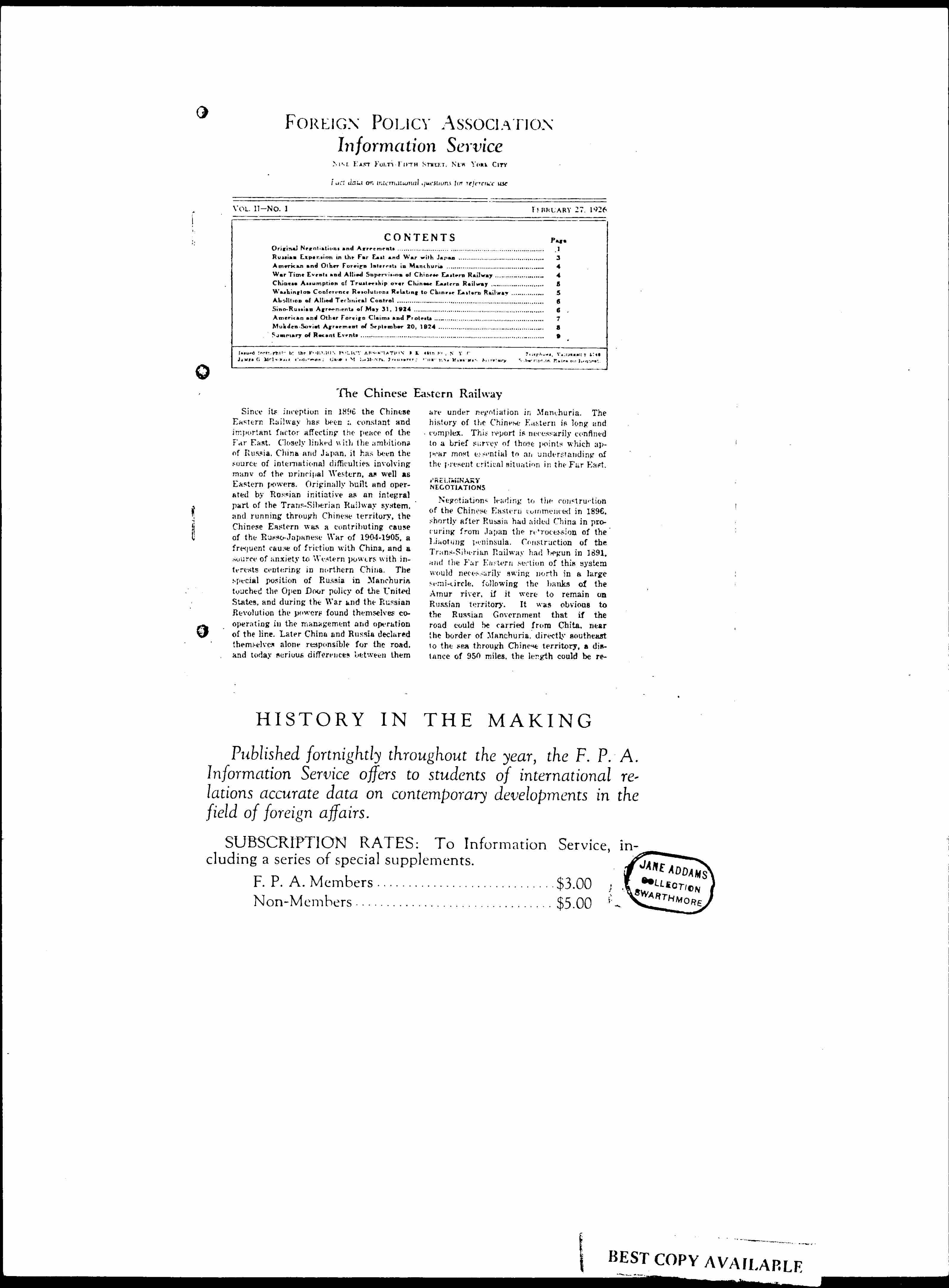Fact data on international questions for reference use.
VOL. II -- NO. 1
FEBRUARY 27, 1926
| CONTENTS | Page |
| Original Negotiations and Agreements .......... | 1 |
| Russian Expansion in the Far East and War with Japan .......... | 3 |
| American and Other Foriegn Interests in Manchuria .......... | 4 |
| War Time Events and Allied Supervision of Chinese Eastern Railway .......... | 4 |
| Chinese Assumption of Trusteeship over Chinese Eastern Railway .......... | 5 |
| Washington Conference Resolution Relating to Chinese Eastern Railway .......... | 5 |
| Abolition of Allied Technical Control .......... | 6 |
| Sino-Russian Agreements of May 31, 1924 .......... | 6 |
| American and Other Foreign Claims and Protests .......... | 7 |
| Mukden-Soviet Agreement of September 20, 1924 .......... | 8 |
| Summary of Recent Events .......... | 9 |
| Issued [illegible] by the FOREIGN POLICY ASSOCIATION [9 E.] 45th St., N.Y.C. JAMES G. [illegible], Chairman; [illegible], Treasurer; CHRISTINA MERRIMAN, Secretary |
[illegible] Subscription Rates on Request |
The Chinese Eastern Railway
Since its inception in 1896 the Chinese Eastern Railway has been a constant and important factor affecting the peace of the Far East. Closely linked with the ambitions of Russia, China and Japan, it has been the source of international difficulties involving many of the principal Western, as well as Eastern powers. Originally built and operated by Russian initiative as an integral part of the Trans-Siberian Railway system, and running through Chinese territory, the Chinese Eastern was a contributing cause of the Russo-Japanese War of 1904-1905, a frequent cause of friction with China, and a source of anxiety to Western powers with interests centering in northern China. The special position of Russia in Manchuria touched the Open Door policy of the United States, and during the War and the Russian Revolution the powers found themselves cooperating in the management and operation of the line. Later China and Russia declared themselves alone responsible for the road, and today serious differences between them are under negotiation in Manchuria. The history of the Chinese Eastern is long and complex. This report is necessarily confined to a brief survey of those points which appear most essential to an understanding of the present critical situation in the Far East.
PRELIMINARY NEGOTIATIONS
Negotiations leading to the construction of the Chinese Eastern commenced in 1896, shortly after Russia had aided China in procuring from Japan the retrosession of the Liaotung peninsula. Construction of the Trans-Siberian Railway had begun in 1891, and the Far Eastern section of this system would necessarily swing north in a large semi-circle, following the banks of the Amur River, if it were to remain on Russian territory. It was obvious to the Russian Government that if the road could be carried from Chita, near the border of Manchuria, directly southeast to the sea through Chinese territory, a distance of 950 miles, the length could be re- [missing page(s)?]
HISTORY IN THE MAKING
Published fortnightly throughout the year, the F.P.A. Information Service offers to students of international relations accurate data on contemporary developments in the field of foreign affairs.
SUBSCRIPTION RATES: To information Service, including a series of special supplements.
F.P.A. Members .......... $3.00
Non-Members .......... $5.00





Comments